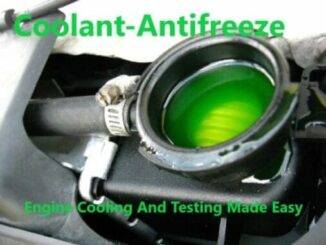
First, when was the last time you checked to see if you had a, bad radiator cap ?
The radiator cap is a very important part of the engine’s cooling system. But, it is often overlooked, when troubleshooting the system.
So, radiator caps are designed to ensure that the prescribed pressure in the cooling system, is maintained at all times.
Some of the signs of a bad radiator cap, can cause damage to other parts of the cooling system.
First, cooling systems are under pressure, to increase the boiling point of the coolant. As a result, this allows the system to operate efficiently, without boiling off the coolant and overheating the engine. But, a loose or bad radiator cap, will cause the system not to pressurize, resulting in overheating.
In this case, the coolant is more likely to be lost to boiling off, than by simple evaporation. Also, a bad radiator cap, cannot effectively seal off the system, nor keep it properly pressurized. And, that will stop the cooling system from working properly.
So, when performing routine cooling system maintenance or repairs, always inspect the radiator cap and replace it if necessary.
Common Failure Signs Of A Bad Radiator Cap:
- Leaking Coolant
- Overflowing Reservoir
- Radiator Hose Collapses
- Air Inside the Cooling System
- Overheated Engine (the most common cause)
- Steam Coming From The Engine
So, The Radiator Cap, Actually Does Several Things:
- Seals the system, against the outside world. (main seal function)
- It will keep the system pressurized when needed, while raising the boiling point of the coolant.
- Allows excess pressure and coolant expansion, to vent to the coolant recovery tank. (pressure seal function)
- Allows coolant to return to the radiator, when the engine cools down. (return seal function)
- If it can’t do those things, those are the signs of a bad radiator cap.
The Radiator Cap Has Three Seals:
- The main seal, is the one that seals the cap, against the top of the filler neck. Just a rubber gasket that operates just like one, on the lid of a pickle jar. Simple and reliable.
- A failed pressure seal, will allow the coolant to boil at a lower temperature. This will allow coolant to be able to travel freely and foamy, to the coolant recovery tank. It will cause, localized hot-spots inside the engine. This will lead to early head warping, and may hasten head gasket failure. Finally, it will cause the rad coolant level to be low, just like a failed head gasket.
- A failed return seal, may prevent the coolant from, returning to the radiator, as the rad cools off. It could cause a vacuum, that can collapse the radiator hoses. This will prevent the coolant from circulating, if the hoses don’t expand, as the engine warms up.
Signs of a bad radiator cap, may even cause similar symptoms just like, a failed head gasket. So, it’s a cheap first step to try, before bringing it in.
But, if you replaced the bad radiator cap and you still have bubbles in the coolant (or foam in the reservoir), then suspect the head gasket.
So, if the engine starts to overheat at idle, and the gauge goes down when you rev it. Then, the coolant is probably low. Moreover, a neglected cooling system, can load up the cap, with crud and corrosion. As a result, stopping proper coolant flow in, and out of it.
Peel the seals back, to check for goop. And, if you find any a blast with a garden hose and brush, should clear most of it out.
How To Test The Cap
First, test the large pressure relief valve by pressing it in against its spring, some effort is needed. Also, make sure that the small valve in the centre of it moves freely.
A rough check on a cap’s working efficiency is to first warm up the engine. Then, wearing a glove, loosen it to its first stop. But, do not remove the cap .
If there is no hiss of escaping air or steam, the cap is probably not maintaining the correct pressure. Those are signs of a bad radiator cap, and it should be replaced.
Make sure that the new cap has the correct pressure rating. A pressurised system raises the boiling point of coolant. But, if the valve is too weak, the pressure will not be maintained. And, if it is too strong the system may become over pressurised, when the engine is hot.
In Summary: Bad Radiator Cap
So, a new radiator cap, is usually less than $20. In other words, just change it every 5 years, just in case.
Thank You !!




